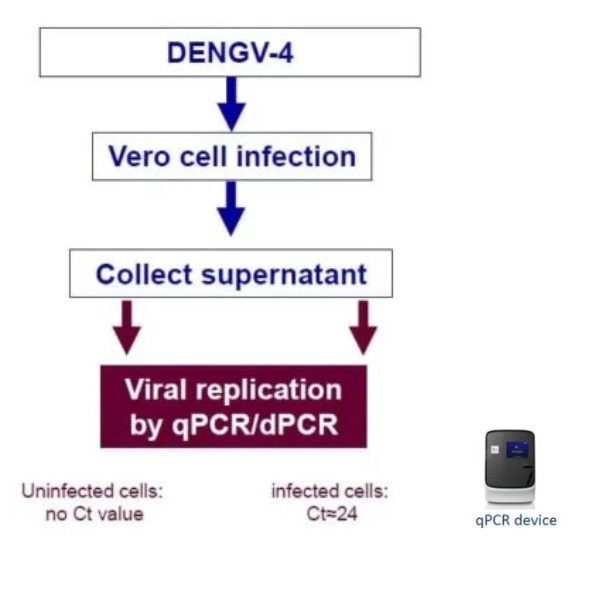


Support the development of vaccines and innovative therapies by providing relevant dengue virus models
The need for dengue disease models is critical as its transmission continues to rise. Since only humans develop symptoms, it’s important to consider the strengths and limitations of each animal model in research.
At Oncodesign Services, we are committed to support therapeutic solutions by offering relevant in vitro and in vivo models, along with advanced facilities and equipment for R&D programs.
What is Dengue virus?
Dengue is a mosquito-borne viral disease, like yellow fever, Zika, and Chikungunya, posing a growing public health challenge, especially in tropical and subtropical regions. With around 50 million cases annually and 2.5 billion people at risk, dengue causes a range of symptoms from mild fever to severe dengue hemorrhagic fever (DHF), which can be fatal. There are four serotypes of the dengue virus.
Preclinical evaluation of new vaccines and therapies using dengue virus models
For preclinical testing of new dengue vaccine candidates, in vitro assays and in vivo models are crucial for understanding immune responses and biomarkers. Research has identified initial target cells of infection, leading to infection models in primary human cell cultures. Mouse-human chimeras with these target cells are also advanced animal models. These developments aim to overcome the limitations of past testing methods and propose more relevant antiviral and vaccine candidates.
- In vitro assays
- Viral & gene expression analysis:
- viral expression by cell imaging
- cytokine expression
- viral load by RT-qPCR (relative value) & digital PCR (absolute value in number of viral copy)
- viral replication with commercial kit
- Binding & neutralization analysis:
- compound binding
- antibody neutralization
- inhibition of infectivity
- Further analyses:
- colorimetric assay when cytopathogen effects exhibited
- immufluorescence with HCS imaging (ImageXpress® Pico technology)
- viral-induced cytotoxicity
- cell viability (cytotoxicity of candidate without virus)
- Viral & gene expression analysis:
- In vivo models
- No other living being besides humans show signs of dengue disease, even after inoculation of high virus dose however mouse–human chimeras are developing symptoms and become a relevant animal model.
- In silico models
- Evolutionary and epidemiological relationships analysis using computer algorithms to highlight specific dengue virus genetic variants or genotypes responsible for outbreaks of more severe disease.
Oncodesign Services offers Dengue virus models for your preclinical programs
At Oncodesign Services, our laboratories are certified to handle BSL2 and BSL3 pathogens such as dengue viruses. Our models help researchers develop vaccines, therapeutics, and other control measures
With our network of partners, we can also provide in vivo testing until clinical trials to study the efficacy of new therapies against Arboviruses.
Case studies – In vitro model: DENGV2/DENGV4-mRNA quantification
As a non-cytopathogenic virus (meaning that virus infection doesn’t lead to cell apoptosis), dengue virus cell infection cannot be performed by classic colorimetric test / viability test. Unstead, we used another method to quantify the viral load and assess the efficacy of antiviral compounds.
- Dengue virus characteristics: we worked with dengue virus 2 and 4 which are the most common dengue viruses. They are approximatively 11 kilobases long with the structure below:

- Experimental protocol: As a non-cytopathogenic virus, we used cell culture supernatant to quantify the virus load under different conditions. mRNA is quantified using a qPCR device.

- Virus amplification and quantification:
- DENGV-2 and DENGV-4 isolated targeting Vero cells
- Universal primers and probe selected

- Kinetic and PCR cycles number: By assessing the kinetic of the dengue virus, we identified that the virus is detectable from 5 days post inoculation.The number of PCR cycles (detectability threshold) depend on the strain of the virus:
- Ct ≈ 24 for DENGV4
- Ct ≈ 29 for DENGV2
This in vitro dengue virus model, developed in our BSL3 laboratories, allows us to screen antiviral candidates by evaluating:
- Antiviral activity
- Kinetic
Needs for Dengue viruses models? Contact-us!



